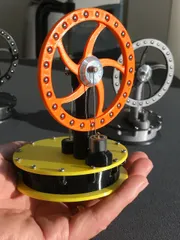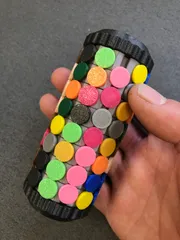Mondrian Table Lamp
Description
PDFA multi-colour table lamp inspired by the Dutch painter Piet Mondrian that you can easily print without a multi-material printer, 180mm high by 122mm square.
Print instructions
edit 17/9/20 - All parts now printed in PLA and some size tweaks
To make the four-colour lamp you need to print the following:
- 4x Mondrian lamp frame
- 1x Mondrian lamp top
- 1x Mondrian lamp bottom
- 1x Mondrian lamp four-colour panes red
- 1x Mondrian lamp four-colour panes white
- 1x Mondrian lamp four-colour panes blue
- 1x Mondrian lamp four-colour panes yellow
To make the two-tone lamp you need to print the following:
- 4x Mondrian lamp frame
- 1x Mondrian lamp top
- 1x Mondrian lamp bottom
- 1x Mondrian lamp two-tone panes grey 1
- 1x Mondrian lamp two-tone panes grey 2
- 1x Mondrian lamp two-tone panes white 1
- 1x Mondrian lamp two-tone panes white 2
To make the monochrome lamp you need to print the following:
- 4x Mondrian lamp frame
- 1x Mondrian lamp top
- 1x Mondrian lamp bottom
- 1x Mondrian lamp monochrome panes 1
- 1x Mondrian lamp monochrome panes 2
- 1x Mondrian lamp monochrome panes 3
If you want to change the patterns and colours you can print the individual panes in the following quantities:
- 15x Mondrian lamp pane size 1
- 13x Mondrian lamp pane size 2
- 9x Mondrian lamp pane size 3
- 4x Mondrian lamp pane size 4
- 17x Mondrian lamp pane size 5
- 13x Mondrian lamp pane size 6
You will need this USB lamp, widely available on the internet:
DZYDZR 3W USB LED Light Magnetic Lamp
The lamp does generate a small amount of heat but I have tested it for many hours and there are no problems.
Alternatively you can bundle a string of USB fairy lights inside but the effect is not so good due to the uneven distribution of light.
The frame components are printed in Prusament galaxy black PLA on the textured PEI sheet using the stock Prusament PLA profile in Prusaslicer.
The coloured panes are printed in Basicfil PLA on the textured PEI sheet using the default Prusament PLA profile in Prusaslicer modified to a bed temperature of 65° and no fan.
Assembly
Refer to the assembly pictures for the relevant colours and patterns for the sides (type 1 & 2) and the top frame.
Fit all the panes into the frames, they will need a firm press fit into the pockets on the inside faces of the frames. Make sure the corners are fully pressed in.
Fit the lamp into the pocket in the base and pass the cable through the slot at the back.
Fit the left and back frames into the slots in the base, and then fit the front and right, they should fit easily. Note the alignment of the coloured panes.
fit the top frame over the front, back and side frames and gently press it down. It should fit easily.
Your Mondrian lamp is now finished, enjoy!
Tips
The parts are dimensioned to fit perfectly on my Stock Prusa Mini but I would suggest printing a couple of individual coloured panes to test for fit before printing the full pane sets.
If you find the panes are too loose you can either increase the X & Y scaling or put a dab of superglue on the edges before fitting them. Take care to avoid getting glue on the visible faces.
If you find the panes are too tight you can reduce the X & Y scaling.
Tags
Model origin
The author hasn't provided the model origin yet.



